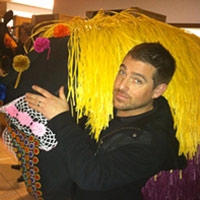Curatorial Statement
Nato Thompson, Chief Curator, Creative Time

A herd of horses has been unleashed in Grand Central Terminal. Grazing in Vanderbilt Hall, they move at a pace perhaps too slow for the needs of a commuter, seeming to ask us to slow down. To take a second. To look. Visitors are suddenly lured into a pasture of altered perception as they come upon this visually evocative herd of Soundsuits— artist Nick Cave’s meticulously handcrafted sculptures, transformed by pairs of performers into fantastical creatures. The peculiar breeds reflect and dislocate Grand Central Terminal’s dizzying sense of wonder. Amidst the buzz of the station a swooshing sound emerges, the fibrous material of the horses’ coat brushing up against itself, a calm, windlike sound. The sound of slow time.
The otherworldly creatures in HEARD•NY bring to mind the historical evolution of the City—the predecessors of modern transportation freed from their harnesses. While the rail lines were built originally for horse-drawn passenger cars, by the early 1900s steam locomotives and electric technologies precipitated the need for a state-of-the-art terminal on 42nd Street. Whether pulling a carriage or a plow, the horse has long been a friend of getting things done and getting somewhere.
The pulse of New York City is made tangible in Grand Central Terminal. Erected as a monument to transportation, this luminous space of glorious grandeur captures the crowded rhythms of an urban nerve-center. Upon entering, one is greeted by a global city in motion. The moving figures in its Main Concourse can become abstracted, dissolving into the hypnotic pace of our contemporary moment. In the station, you can either move through the circuits of transport, or step outside of the fray to witness the beautiful choreography of humanity navigating this complexity without so much as a second thought.
Both an awe-inspiring, historical landmark and a checkpoint in the daily grind, Grand Central Terminal houses both the sacred and the profane. As a profound monument and mediator keeping the tempo of our times, it becomes a Rorschach test of this contemporary period—a period of people in movement.
On the brilliant sky that is the ceiling of the Main Concourse—rediscovered after peeling back the black tar remnants of a bygone era of cigarette-smoking commuters—there is Pegasus. Emerging from a cloud, it joins other mythical figures in a celestial canopy above the commuting population. With HEARD•NY, it feels as if this magical creature has drifted down onto the marble floors of Vanderbilt Hall, where it has summoned more horses to gather, speaking in tongues, whispering secrets in a language that may otherwise have been lost in time.
In their swaying movements, they act as temporal and visual sirens, beckoning and asking the commuter to pause. Resisting the speed of the building occupants, they speak to a pre-industrial period of gathering and groups. They do not try to sell you anything, nor tell you where to go, what to believe, or who you are.
Aesthetically imparting the festivalism of the film Paris is Burning and Mardi Gras Indians, they also mark a slow celebration happening in the dimension of our senses. In this public space, we have the chance to collectively hallucinate.
The horses’ electrifyingly colorful coats reference a range of influences, from contemporary fashion, to Southeast Asian embroidery, and particularly African ceremonial costumes. Their breathtaking complexity and corollary allure are all part of an international visual language of hybridity that swirls in the eddy of Grand Central Terminal itself.
In the frantic pace of our contemporary age, in the monumental machine that is Grand Central Terminal, we are temporarily placed outside ourselves by crossing paths with Cave’s creations. We can observe these horses in the same way that we look upon our fellow travelers in the Main Concourse, sensing the texture of time and the dizzying visual seduction that is the pleasure and bewilderment of our contemporary moment.
